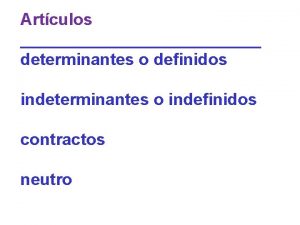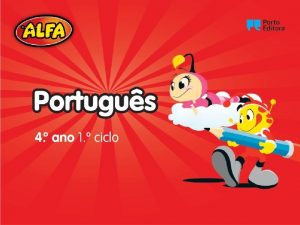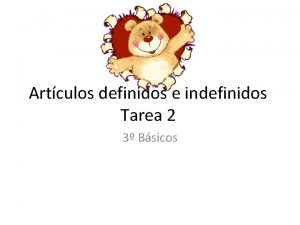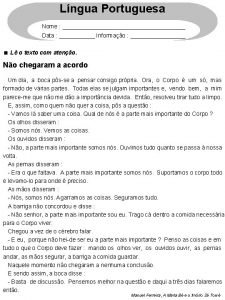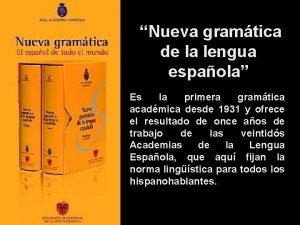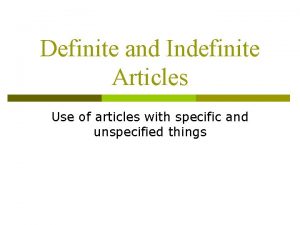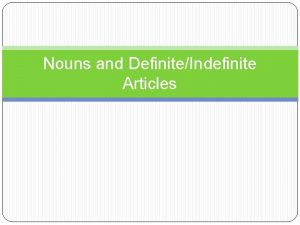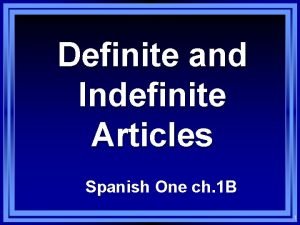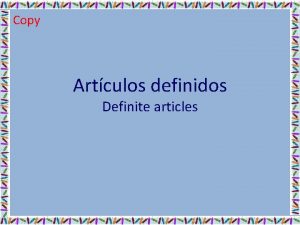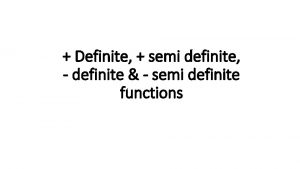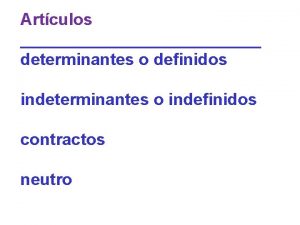Gramtica Artculos definidos y Artculos indefinidos Definite articles












- Slides: 12

Gramática: Artículos definidos y Artículos indefinidos -Definite articles and Indefinite articles- Follow us on Facebook: GH Spanish Tutor

Follow us on Facebook: GH Spanish Tutor Artículos DEFINIDOS o DETERMINADOS Artículos INDEFINIDOS o INDETERMINADOS -Definite or determinate Articles- -Indefinite or indeterminate Articles- el la los las lo ARTÍCULOS -Articles- un una unos unas (neuter) THE A – AN – SOME

Follow us on Facebook: GH Spanish Tutor Artículos DEFINIDOS o DETERMINADOS Artículos INDEFINIDOS o INDETERMINADOS -Definite or determinate Articles- -Indefinite or indeterminate Articles- Algo que ya conocemos Something we already know ARTÍCULOS -Articles- Algo que NO conocemos previamente Something we DON’T know previously

Follow us on Facebook: GH Spanish Tutor Diferentes usos de los Artículos – Different uses of the articles –

Follow us on Facebook: GH Spanish Tutor • 1. DEFINATE ARTICLE (EL, LA, LOS LAS) when talking about likes and dislikes • In Spanish we MUST use these articles Me encanta el zumo de naranja No me gustan las películas de suspenso, prefiero las peliculas cómicas Me gustan los deportes en general Detesto el café con leche

Follow us on Facebook: GH Spanish Tutor 2. FEMININE DEFINITE ARTICLE TO TELL TIME (la – las): - Time in Spanish are all feminine (because we are talking about “la hora” and is feminine) and we have to include the feminine article. - Es la una de la mañana - Son las cinco y veinte - A las tres y media - Mis clases empiezan a las ocho y cuarto

Follow us on Facebook: GH Spanish Tutor 3. When talking about days of the week use MASCULINE DEFINITE ARTICLE (el – los): - Because we are talking about “el día” and is masculine - When we talk about one specific day of the week, use “el”: - Viajaré a Lima el martes próximo (I will travel to Lima next Tuesday) - When talking about something habitual or something happens every week, use “los” - Visito a mis padres los domingos (I visit my parents every Sunday)

Follow us on Facebook: GH Spanish Tutor 4. WE DON’T USE ANY ARTICLE WHEN WE TALK ABOUT: - Profession, nationality, religion, and other abstract ideas to describe our identities. - Soy profesor de español (I am a Spanish teacher) - Ella es cubana (She is a Cuban) - However, if we want to add more information we insert an indefinite article: (un-una) - Es una buena estudiante de español (She is a good Spanish student) - Él es un niño muy educado (He is a well educated/polite boy)

Follow us on Facebook: GH Spanish Tutor 5. WE DON’T USE ANY ARTICLE WHEN WE TALK ABOUT AN UNSPECIFIED QUANTITY: - In English we use “some” or “any” to talk about unspecified quantity of something or with uncountable noun: - I’d like some mashed potatoes - I don’t fancy any drink - In Spanish we don’t need them. - Me gustaría puré de patatas - No me apetece ninguna bebida

Follow us on Facebook: GH Spanish Tutor 6. WE USE UNDEFINATE ARTICLE “un – una” FOR EMPHASIS AND COLLOQUIALLY: - In Spanish we use the verb “tener” to express states of being: - Tener dolor (to be hurt), tener prisa (to be in a hurry), tener calor (to be hot), tener sed (to be thirsty), tener frío (to be cold), tener suerte (to be lucky), etc. - We can add the appropriate indefinite article (un, una) to add emphasis or urgency in colloquial contexts. - ¡Tengo una suerte con las chicas, tío! (I’m so lucky with girls, dude!) - ¡Tengo un calor, madre mía, que no lo soporto! (I’m so hot, mother of God, I can’t stand it!)

Follow us on Facebook: GH Spanish Tutor 7. HOWEVER, BE CAREFUL WHEN YOU USE AN ARTICLE THAT STARTS WITH “a”: - If the noun starts with a stressed letter “a”, the article will change to “el”. This is to avoid the “forced” sound of two “as” next to each other. For example: - La agua (water) el agua - La águila (eagle) el águila - But, if you are using it in plural, the article goes back to its feminine form. For example: - Aguas las aguas - águilas águilas

Follow us on Facebook: GH Spanish Tutor 8. THE “NEUTER” ARTICLE “lo”: - Sometimes is possible to pair an article (el, la) with an adjective (describing word) to make it into a noun (object word). - In this case we use the “Neuter article” lo - It is neuter because it doesn’t describe a specific gender. For example: - A mí me gusta mucho lo dulce I like sweet things a lot Resources: www. fluent. com www. spanishdict. com
 Articulos contractos
Articulos contractos Determinantes demonstrativos francês
Determinantes demonstrativos francês Los articulos definidos
Los articulos definidos Articulos definidos e indefinidos
Articulos definidos e indefinidos Relaciona cada parte del refran
Relaciona cada parte del refran Determinantes artigos definidos e indefinidos
Determinantes artigos definidos e indefinidos Gramtica inglesa
Gramtica inglesa Que es la gramtica
Que es la gramtica Definite and indefinite nouns
Definite and indefinite nouns Definite and indefinite articles spanish
Definite and indefinite articles spanish Definite articles in spanish
Definite articles in spanish Italian definite article
Italian definite article Definite vs indefinite articles spanish
Definite vs indefinite articles spanish
